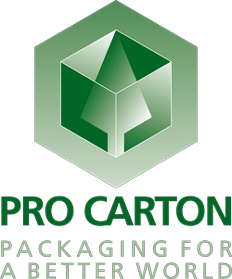Smart does it
4 April 2016
Peter Aldous is Creative Service Director at Elmwood in London - a specialist putting creative ideas into practice. Pro Carton talked to him about trends in packaging and sustainability.
Peter Aldous discusses clients’ wishes and designers’ ideas to see where they lead to, if they will achieve what the brand needs and to find ways for their implementation – like a gatekeeper examining intentions, feasibility and cost-efficiency of the projects.
What is the focus of your work with clients?
At the beginning of a project we meet with people from marketing, research and development as well as purchasing. In my role our clients are looking for a way to bridge the gap between design and downstream suppliers who provide the final printed result. Clients usually stay with us for several projects over longer periods of time, so we know their brands and intentions very well and often build a stable relationship.
Customers and designers come up with a wide range of ideas. My task is to take a design intent that stays feasible throughout the process, from creation to shelf. And of course to control costs. This requires a team effort from all key stakeholders, great communication and most importantly strict adherence to guidelines set out.
What has changed in packaging and branding since you started working?
I have been in this industry for over 26 years, so have seen many changes. From adoption of computers and Macs to digital processes that allow greater detail and efficiency. The possibilities concerning optic and haptic design have hugely increased, so my work is much more complicated than it was before.
The main important change though is the interaction of technology and consumers. From smartphone experiences to e-commerce. Platforms that allow a greater choice and have packaging as a vital point to play. Packaging today more than ever interacts with the consumers, so we focus a lot on how this is best achieved effectively. In the past, the barcode was about the most communicative element, now we have much better elements like QR-Code and RFID. The costs for printing RFID are quite low today, so it is just a question of time until we see more applications of these. But it takes time to find the perfect concept so they are of use for both supply chain and customers.
An important trend is digital printing, as the quality is high nowadays and there are many possibilities. Clients tend to think more in delivery charges and change for example a label with different charges in different channels, with a different idea for each channel or with bespoke printing for short runs or even personalization. So generally speaking, there is much more communication around the packaging today.
Another important trend is smart packaging: for example, different opening systems and apertures for pouring the content. For example, we had to find a solution for a baby milk powder that ensures that there is nothing left inside the package and wasted afterwards. Smart concepts often also try to reduce packaging material – so good convenience, usefulness and elegance ideally merge into one smart solution.
How important is sustainability to you?
The most important thing about packaging is that it sells, of course. You cannot design something that is not effective. It needs to be feasible and have as little impact on the environment as possible at the same time. Sustainability is as important as many other factors in design. However, many recommendations we give can only form part of the clients’ initiative on sustainability. It is important we bear this in mind and quite rightly place this topic high on our agenda.
We often engage our partners at Tin Horse, a structural packaging agency, who have specialist knowledge in sustainability and cost-reduction.
Is packaging today more important than it used to be?
The role of packaging today in general is not more important than it was before: It has always been paramount, because packaging is the touchpoint of the brand, the point of contact. Especially if you have a new product, consumers should be able to feel proud when they pick it up.
But e-commerce changes the communication on the packed product. On the one hand, communication has to be simple. The less information you have to communicate, the clearer the message and the bigger the impact. On the other hand, consumers want to know more about products today, so sometimes there is also more information on the packaging, although sometimes it suffices to have this information on the internet. There is a big demand for clever concepts to solve this dilemma and to find a convincing concept, ideally in a succinct way and not overloaded.
Innovations as we will see at Drupa very soon will showcase all our industry trends. Already we have seen cost improve in many processes. We have seen cast and cure and printed electronics move more into clients’ minds.
How would you describe the role of cartonboard in packaging?
Depending on the SKU (stock keeping unit) and process, it differs in front of mind. On the one hand, there are frozen pizza boxes in supermarkets looking for alternatives that could foster sales. On the other, premium products can only be in cartons. We see cartonboard as just as important and relevant now as it always has been. Take the iPhone for example, how would you deliver that in a flexible bag? It doesn’t quite have the same premium soft touch feel. The opening ceremony of sliding the box away from its internal housing with almost vacuum like perfect experience. Tough to match without cartonboard.
www.elmwood.com
www.twitter.com/ElmwoodTweets




